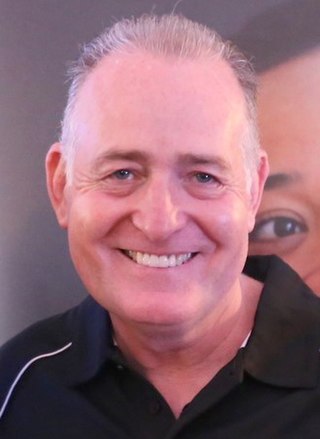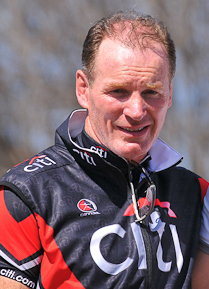
Matthew Coleman Burke is an Australian former international rugby union player and sport presenter on Sydney's 10 News First.
Chris Latham is an Australian former rugby union player who enjoyed a distinguished representative career with the Wests Bulldogs, Queensland Reds and Australia between 1998 and 2007 before signing with Worcester Warriors in the UK and later Japanese club Kyuden Voltex.

David Ian Campese, AM, also known as Campo, is a former Australian rugby union player (1982–1996), who was capped by the Wallabies 101 times, and played 85 Tests at wing and 16 at fullback.

Stephen Larkham is a retired Australian rugby union professional player, currently in the role of head coach for Brumbies. He spent his career with the Brumbies in Super Rugby, for whom he played from the inception of the professional Super 12 in 1996 through 2007. He is best known for his long tenure with the Wallabies at international level, for whom he played 102 times. After initial selection at fullback from 1996 to 1997, Larkham was the first-choice Australian fly-half from 1997 to 2007, playing in the 1999, 2003 and 2007 Rugby World Cups. He is married to Jacqueline and has two children, Jaimee and Tiahna.
Mathew Steve Rogers is an Australian former professional rugby league footballer who played in the 1990s, 2000s and 2010s. He also played rugby union at the highest level, becoming a dual-code international.
Michael Patrick Thomas Lynagh, is an Australian former rugby union player who played mainly as a fly-half. Lynagh represented Australia from 1984 to 1995, playing at both inside centre and fly half. Lynagh was capped 72 times for Australia, and was captain from 1993 to 1995. He was the world points scoring record holder when he retired, with 911 points.
Mark Gordon Ella, AM is an indigenous Australian former rugby union footballer. Ella played at flyhalf/five-eighth and was capped by the Wallabies 25 times, captaining Australia on 10 occasions.

Simon Paul Poidevin is a former Australian rugby union player. Poidevin made his Test debut for Australia against Fiji during the 1980 tour of Fiji. He was a member of the Wallabies side that defeated New Zealand 2–1 in the 1980 Bledisloe Cup series. He toured with the Eighth Wallabies for the 1984 Australia rugby union tour of Britain and Ireland that won rugby union's "grand slam", the first Australian side to defeat all four home nations, England, Ireland, Wales and Scotland, on a tour. He debuted as captain of the Wallabies in a two-Test series against Argentina in 1986, substituting for the absent Andrew Slack. He was a member of the Wallabies on the 1986 Australia rugby union tour of New Zealand that beat the All Blacks, one of six international teams and second Australian team to win a Test series in New Zealand. During the 1987 Rugby World Cup, he overtook Peter Johnson as Australia's most capped Test player against Japan, captaining the Wallabies for the third time in his 43rd cap. He captained the Wallabies on a fourth and final occasion on the 1987 Australia rugby union tour of Argentina before injury ended his tour prematurely. In 1988, he briefly retired from international rugby, reversing his decision 42 days later ahead of the 1988 Bledisloe Cup series. Following this series, Poidevin returned to the Australian side for the single 1989 Bledisloe Cup Test. He returned full-time to the Australian national squad for the 1991 season. Poidevin was a member of the Wallabies that won the 1991 Rugby World Cup, after which he retired from international rugby union.

Randwick District Rugby Union Football Club, also known as the Galloping Greens, is an Australian rugby union club which competes in the Sydney premier grade rugby union competition. The club was formed in 1882 and since then has won 32 first grade premierships and six Australian club championships. It is one of the traditional powerhouses of the Shute Shield competition, winning 14 titles from 1978 to 1996. Randwick's colours are myrtle green and the club's home ground is Coogee Oval. In the 1980s the club produced many Wallabies, including the Ella brothers. Its history has seen many of Australia's best players represent the club, including the likes of George Gregan, Rocky Elsom and David Campese. In all, 93 Randwick players have pulled on a Wallaby jersey, and nine have had the honour of captaining their country.
Brendan Moon is an Australian former rugby union wing who played for the Queensland Reds in the late 1970s and early 1980s. Moon played 100 games for Queensland and also played in the premiership winning Brothers Old Boys team of 1978, 1980–1983, Brendan also represented Australia in 35 tests and was considered one of the best finishing wingers in the game with excellent positional play and terrific acceleration.
Andrew Gerard Slack is an Australian former state and national representative rugby union player who captained the Wallabies in 19 Test matches in between 1984 and 1987. His 133 appearances for Queensland between 1975 and 1987 stood as the state record until bettered by Mark Connors in 2006.
The 1984 Australia rugby union tour of Britain and Ireland was a series of eighteen matches played by the Australia national rugby union team in Britain and Ireland between 17 October and 15 December 1984. The Australian team won thirteen matches, drew one and lost four but notably won all four of their international matches.
Colin "Col" Windon, was a rugby union player and soldier who captained Australia – the Wallabies – in two Test matches in 1951. By age 18 Windon was playing at flanker for his club Randwick in Sydney's Shute Shield. After serving with the Second Australian Imperial Force in the Pacific Theatre during the Second World War, Windon resumed his rugby career in 1946. He was first selected for Australia for their tour of New Zealand that year. Despite the Wallabies losing both their Tests on tour, Windon impressed with his play.
The 1991 Rugby World Cup Final was the final match of the 1991 Rugby World Cup, the second edition of the rugby union competition, to decide the world champions. The match was played on 2 November 1991 at Twickenham Stadium, London, and was contested by the host nation England, and Australia. Australia won the match 12–6.
The 1981–82 Australia rugby union tour of Britain and Ireland was a series of matches played by the Australia national rugby union team. The touring team played twenty-three matches between October 1981 and January 1982, winning sixteen games, drawing one and losing six. The scheduled final game, against the Barbarians, was cancelled due to heavy snow.
The 1983 Argentina rugby union tour of Australia was a series of seven matches played by the Argentina national rugby union team in Australia in July and August 1983.
The 1982 Australia rugby union tour of New Zealand was a series of fourteen matches played by the Australia national rugby union team in New Zealand between July and September 1982. The Wallabies won ten of the fourteen matches and lost the other four. The international match series against the New Zealand national rugby union team resulted in a 2–1 win for New Zealand, who won the first and third matches, with Australia winning the second match. New Zealand thereby regained the Bledisloe Cup, which had been held by Australia since 1979.
The 1983 Australia rugby union tour of Italy and France was a series of matches played between October and November 1983 in Italy and France by Australia.
The 1991 Australia rugby union tour of New Zealand consisted of two matches played by the Wallabies in August 1991.




